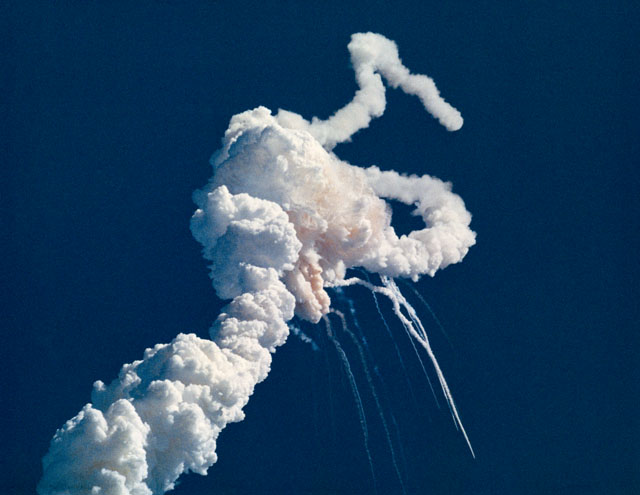
Thirty years ago, on 28 January 1986, one of the worst and most public disasters in U.S. space history unfolded with horrifying suddenness in the skies above Cape Canaveral. The sight of Challenger exploding, just 73 seconds after liftoff, killing all seven crew members, is so harrowing that for all of us who witnessed it live, it still carries the power to haunt. Over the minutes, hours, days, weeks, months, and years to come, it would be played out again and again via television and later the Internet. The ramifications of the Challenger accident were so profound that they entirely reshaped the subsequent history of the shuttle program. An innocence, astronaut Robert “Hoot” Gibson once said, was lost on 28 January 1986, and never again would words such as “safe” or “routine” or “easy” be employed to describe the fleet of reusable orbiters, the brave souls who flew them, or the work they did. The loss of Challenger served as a stark reminder of the sheer dangers involved in space exploration and the unforgiving nature of high technology.
However, getting Challenger into orbit on Mission 51L that freezing day, all those years ago, proved an exercise in frustration. It was a frustration that NASA could ill-afford. As well as deploying the second Tracking and Data Relay Satellite (TDRS-B) and the Spartan-203 free-flying spacecraft to observe Halley’s Comet, the six-day flight would feature the first private citizen to fly aboard the shuttle: a social studies high school teacher from Concord, N.H., named Christa McAuliffe. Picked from thousands of applicants for the “Teacher in Space” initiative in July 1985, she was to teach two lessons from space, providing a publicity boost for the space agency as it sought to demonstrate that its reusable fleet of orbiters were operational … and to convince senior politicians to support a permanent space station. Years later, McAuliffe’s mother, Grace Corrigan, would insist that the general atmosphere in the weeks leading up to Challenger’s fateful launch was that the shuttle was far safer than an airliner, simply due to the higher number of precautions taken by NASA.
In August 1984, President Ronald Reagan announced the Teacher in Space project, requesting NASA to find a gifted educator with the ability to communicate enthusiasm to students from orbit. The not-for-profit Council of Chief State School Officers was selected by NASA to co-ordinate the selection process, and from November 1984 until February 1985 more than 11,000 applications were submitted. These were winnowed down to 114 semi-finalists by state, territorial, and agency review panels, and McAuliffe was one of only two teachers to be nominated in New Hampshire. In her application she wrote: “I cannot join the space program and restart my life as an astronaut, but this opportunity to connect my abilities as an educator with my interests in history and space is a unique opportunity to fulfil my early fantasies. I watched the space program being born and I would like to participate.”
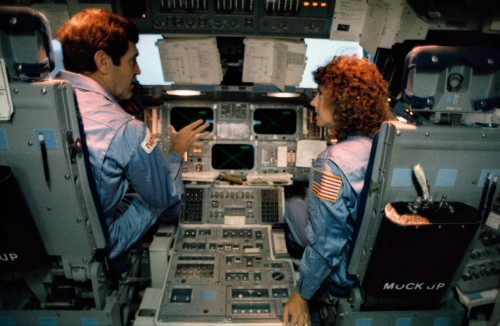
A judging panel, including former astronauts, university presidents, actress Pam Dawber, former basketball player Wes Unseld, and Robert Jarvik, inventor of the artificial heart, presided over these candidates at interview and eventually narrowed the list to 10 finalists. On 26 June 1985, at the White House, President Reagan remarked to the candidates that “whichever one of you is chosen might also want to take under consideration the opinion of another expert: The acceleration which must result from the use of rockets inevitably would damage the brain, so consider yourself forewarned!” Little could he possibly have known that such dire predictions would come awfully true for the Teacher in Space, early the following year.
Late in July, it was Vice President George H.W. Bush who announced McAuliffe’s name as the prime candidate, backed up by Idaho elementary school teacher Barbara Morgan. NASA psychiatrist Terry McGuire told New Woman magazine that McAuliffe was the most “balanced” of the 10 finalists, whilst other senior officials found that her endearing manner and infectious enthusiasm set her apart from the others. Training in Houston began in September, and by the time the 51L crew arrived at the Kennedy Space Center (KSC) in January 1986, their launch had already been postponed by delays in bringing Columbia home from Mission 61C and weather concerns at a Transoceanic Abort Landing (TAL) site in Senegal. More trouble was afoot. Predictions of unacceptable weather in Florida put paid to a second attempt on the 26th and, when Commander Dick Scobee and his six crewmates settled into their seats aboard Challenger on the 27th, they were again thwarted by high winds and a frozen handle on the hatch.
In the years that followed, many observers commented that launching on Super Bowl Sunday, the 26th, might well have saved 51L. “It’s another case of fate, playing tricks on you,” remembered former NASA Administrator Jim Beggs in an oral history. “They decided not to launch on Super Bowl Sunday … but Super Bowl Sunday was a fine day. If they’d have launched then, they wouldn’t have had any trouble, so they held it over and caught the cold spell and lost the vehicle and the crew.” On the night of Monday the 27th, temperatures at the launch site plummeted, precipitously, to an unseasonal -13 degrees Celsius (8.6 degrees Fahrenheit), forcing technicians to switch on safety showers and fire hoses at Pad 39B to prevent water pipes from freezing. This proved particularly worrisome for the ice inspection team, who began their final “sweep-down” of the pad area in the early hours of the 28th and they were obliged to knock a large number of 12-inch (30-cm) icicles away with broom handles as the countdown clock continued ticking toward launch.
Next morning, the Sun rose on the coldest weather conditions under which a shuttle launch had ever been attempted, a fact that would be investigated in depth during the subsequent presidential inquiry into the cause of the tragic events later that day. The copious amounts of ice on Pad 39B forced an additional two-hour delay to permit thawing. Nonetheless, many of the astronauts’ families, including Scobee’s wife, June, doubted that NASA would fly in such conditions. She was partially appeased by her husband’s insistence, over the phone that morning, that he felt it was safe to do so.
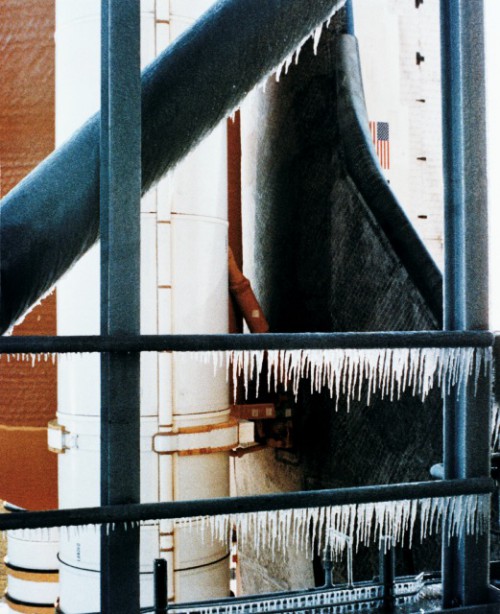
Tragically, as we know, Scobee, McAuliffe, and their crewmates—Pilot Mike Smith, Mission Specialists Ellison Onizuka, Judy Resnik, and Ron McNair, and Hughes Payload Specialist Greg Jarvis—would indeed launch that frigid Tuesday, with catastrophic results. Their ride into the heavens began at precisely 11:38 a.m. EST. Six and a half seconds before liftoff, Challenger’s three main engines thundered to life and, as the countdown clock touched zero, the assembled spectators at KSC were greeted by the ear-splitting staccato crackle of her twin Solid Rocket Boosters (SRBs). It proved to be the failure of both primary and secondary O-ring seals at the base of the right hand booster, Rogers investigators would later conclude from photographic, physical, and other evidence, that was directly and solely responsible for the destruction of 51L and the loss of her crew.
Clear evidence of the boosters’ fallibility, made public for the first time by the Rogers report, occurred serendipitously when, 0.678 seconds after liftoff, a video camera mounted close to Pad 39B captured “a strong puff of grey smoke … spurting from the vicinity of the aft field joint of the right Solid Rocket Booster.” The camera had identified the tell-tale result of both the primary and secondary O-rings—which were meant to stop searing gases from escaping between the joints of the booster segments—failing, disintegrating, and streaming away in the moments after ignition. More significantly, the point of failure directly faced the External Tank and its volatile liquid oxygen and hydrogen propellants. Any flame from the compromised booster could now play on the tank like a blowtorch, igniting its contents in a fireball and destroying Challenger, together with the entire launch complex. Years later, Morton Thiokol structural engineer Roger Boisjoly would express astonishment that the vehicle did not explode on the pad; by an incredible sequence of events, a chunk of solid fuel temporarily plugged the O-ring hole, and the first minute of ascent proceeded normally.
The temporary plug, however, was just that: temporary. It would not hold.
Several more puffs of increasingly denser, darker smoke—further indicative that the products under combustion were indeed the grease, insulation, and rubberized O-ring material from the joint seals—were recorded by other ground-level cameras between 0.836 and 2.5 seconds after liftoff, as the boosters’ hold-down posts were severed and the shuttle commenced its climb away from Pad 39B. As each puff was left behind by Challenger’s upward trajectory, the next fresh puff could be seen close to the level of the joint. The frequency of these emissions was directly related to flexure within the structure of the SRB as the gap in its joint cycled open and closed. The last incidence of smoke above the joint was timed at T+2.733 seconds. In the milliseconds that followed, a combination of atmospheric factors and exhaust from the boosters made it difficult to determine if any more smoke was emerging from the failure point.
A little under eight seconds into the mission, as planned, the vehicle cleared the tower and began a programmed roll maneuver, moving onto the correct flight azimuth for a 28.45-degree orbit, then pitching onto her back under the control of her computers. Shortly thereafter, at T+19 seconds, to prepare herself for passage through a period of maximum aerodynamic turbulence (known as “Max Q”), Challenger’s main engines were throttled down from 104 to 94 percent, and later 65 percent, of rated thrust. Thirty-seven seconds into the ascent, she encountered the first of several high altitude wind shears, lasting until just past a minute after launch. In its inquiry, the Rogers Commission report noted that the shuttle’s guidance, navigation, and control system immediately detected and compensated for these conditions, and—although 51L’s aerodynamic loads were higher than previous missions in both the yaw and pitch planes—the SRBs, too, responded effectively to all commands.
It is possible that the mission may still have proceeded normally, had the plug of solid fuel remained jammed into the O-ring breach. However, by an incredible stroke of cruel luck, Challenger happened to pass through the most severe wind shear ever encountered by an ascending shuttle stack. The shear dislodged the plug around a minute into the mission. After passing through maximum aerodynamic turbulence, 51 seconds into the climb, her main engines were throttled back up to full power; shortly afterward, at 58.788 seconds, a frame of video recorded the first evidence of a flickering flame from the right-hand SRB’s aft joint. The temporary plug of solid fuel had gone, and, although they were oblivious to anything amiss, the crew’s fate was now sealed.
The flame rapidly established itself, growing into a well-defined plume within half a second. Exactly a minute into the mission, downlinked telemetry pointed to an unusual chamber pressure differential between the left and right boosters—the pressure of the latter was some 11.8 psi (81.3 kPal) lower than the other, indicating a leak in its aft joint. As the flame increased in size, Challenger’s aerodynamic “slipstream” deflected it backward and circumferentially by the protruding structure of the upper ring which linked the SRB to the External Tank, focusing the flame directly onto the surface of the tank.
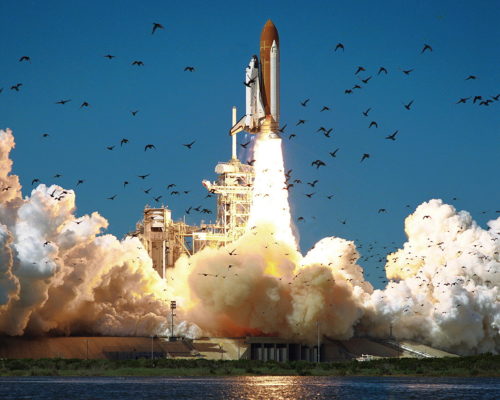
Sixty-two seconds into the ascent, the left booster’s thrust vector control moved to compensate for the yaw motion caused by the reduced thrust from its right-side counterpart. A couple of seconds later came the first visual manifestation that the flame from the damaged booster had breached the lower segment of the External Tank: an abrupt change in the shape and color of the flame, indicating that it was now mixing with leaking liquid hydrogen. Moreover, pressurization data at around this point reinforced the fact that its liquid hydrogen tank was indeed ruptured.
In Mission Control, astronaut Dick Covey—sitting alongside fellow astronaut Fred Gregory at the Capcom’s console—relayed a standard call: “Challenger, Go at throttle up.”
Commander Dick Scobee came back a second or two later. “Roger,” he replied. “Go at throttle up.”
In the seconds that followed, an incredibly rapid sequence of events concluded with the destruction of the External Tank, the separation of both boosters, and the structural disintegration of Challenger. Seventy-two seconds after liftoff, the flame from the right SRB finally burned through the lower of two struts holding it onto the External Tank; pivoting around its upper strut, the top of the booster impacted the inter-tank and the base of the liquid oxygen tank, breaching them both. Nearly simultaneously, around T+73.1 seconds, clouds of white vapor were spotted at the top of the tank and around the area of its bottom dome: the former was clearly indicative of the ruptured liquid oxygen tank, the latter conclusive evidence of structural failure. Almost immediately, at T+73.6 seconds, came a massive—“almost explosive,” read the Rogers investigation’s report—burning of both the hydrogen leaking from the lowermost tank and the oxygen from its uppermost section.
At this point, 51L was at an altitude of 9 miles (15 km) over the Atlantic Ocean, traveling at almost twice the speed of sound, and Challenger was lost from view in the resultant explosive burn. Her Reaction Control System (RCS) ruptured during this period, setting off the hypergolic burning of its propellants, evidenced by a reddish-brown hue around the edge of the fireball. Meanwhile, the two boosters, now released of their loads, rapidly climbed away from the catastrophe, but were remotely destroyed by the Range Safety Officer at 11:39:50 a.m. EST, some 110 seconds after launch. “Obviously a major malfunction,” was all Steve Nesbitt, the stunned launch commentator, could remark.
Even as he spoke, most, if not all, of the 51L crew were still conscious and may have remained so as they tumbled to Earth. Now subjected to aerodynamic loads for which she had not been designed, Challenger had disintegrated into several large fragments. Clearly visible, tumbling away from the blossoming cloud of debris that had swallowed the External Tank, were her aft compartment—with main engines, briefly, still firing—together with one wing and a fuzzy, roughly triangular blob: the forward fuselage, containing the crew cabin, trailing a jumble of umbilical lines ripped from beneath the payload bay floor. It continued, for a time, on an upward trajectory on a ballistic arc that reached a maximum altitude of around 11 miles (18 km), before gravity inexorably pulled it down at close to 250 mph (400 km/h), toward an Atlantic grave.
The loss of Challenger, played out as it was in the most devastatingly public fashion, would bring the shuttle program and NASA to its knees for far longer than the 32 months needed to return the reusable vehicles to flight. As described in a previous AmericaSpace history article, investigators would uncover a range of technical, managerial, and other human factors behind the tragedy, and in September 1988 a safer—though still intrinsically unsafe—shuttle would return to flight.
And with each and every launch that followed, right up to the very end of the shuttle’s 30-year history, the launch phase remained arguably the most critical. For each mission, the 73-second psychological barrier was a powerful hurdle for each crew to overcome. Even as Atlantis rocketed aloft for the shuttle program’s finale on 8 July 2011, many hearts missed a beat as STS-135 Commander Chris Ferguson called “Roger, Go at throttle up” for what would be the last time.
The second part of this article will appear tomorrow.
Be sure to “Like” AmericaSpace on Facebook and follow us on Twitter: @AmericaSpace





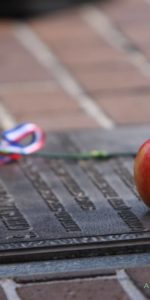
“They decided not to launch on Super Bowl Sunday…but Super Bowl Sunday was a fine day. If they’d have launched then, they wouldn’t have had any trouble, so they held it over and caught the cold spell and lost the vehicle and the crew.”
“-the point of failure directly faced the External Tank and its volatile liquid oxygen and hydrogen propellants. Any flame from the compromised booster could now play on the tank like a blowtorch, igniting its contents in a fireball-”
“-most, if not all, of the 51L crew were still conscious and may have remained so as they tumbled to Earth.”
If not for a stupid football game, if the seal had failed at a different place and the flame not hit the tank, and if the crew had ridiculously cheap parachutes to bail out with….
The retreat from space into LEO after Apollo was all about going cheap. There is no cheap.
The first major wrong turn was the decision to abandon lunar exploration. We took our eyes off the prize.
The second wrong turn was the design of the shuttle, which was a long series of compromises to cut costs and satisfy the military. In hindsight omitting an escape system was…absurd.
The third wrong turn was of course the entire concept of making it pay for itself as a satellite pick-up truck while carrying humans.
The do-everything-pay-for-itself-cargo-bay-of-dreams lives on with the new generation of cheap and nasty hobby rockets promising everything and delivering nothing.
“The ramifications of the Challenger accident were so profound that they entirely reshaped the subsequent history of the shuttle program.”
I have to disagree and say it was not really “profound.” If it had been so then the Shuttle C to lift satellites would have come into service and that never happened.
If it had been “profound” then the originally specified pressure fed boosters would have been developed and that never happened.
If it had been “profound” the idea of “cheap lift” and making space exploration pay for itself would have been dumped in the trash and a lunar return would have been put back on the table.
LEO would have been seen for the dead end it is and Human Space Flight re-defined as actually traveling through space to go somewhere besides endless circles at very high altitude.
LEO is not space.
Yes, Gary we all know LEO isn’t space any nothing interesting happens there…
http://www.worldsciencefestival.com/2015/04/25-greatest-hubble-telescope-discoveries-past-25-years/
http://www.nasa.gov/mission_pages/hubble/servicing/
The counter-narrative that we could have re-built another Hubble without Shuttle also misses the point if you were going to go there. Congress would be very unlikely to fund a second HST with corrected optics after the fiasco of the first one let alone new telescopes with all the upgrades from subsequent missions. The shuttle program taught us a lot about working in space and about maintenance of systems that needed to have durability in space. Shuttle (not some mythical alternative) has provided humanity with one of, if not the most, important scientific instruments ever devised by humans. Shuttle had maintained and improved that instrument over 20 years on orbit. I prefer to think of Challenger as a very tough price to pay for such an amazing opportunity for humanity. As with most mishaps/tragedies it could have been avoided, but we are human. The same humans that got Apollo 13 back and the same ones that led to the tragedy of Apollo 1.
And for you on this forum, especially for this article, to drone on about LEO not being space suggests you really do have a problem. You are some sad sack and have real issues to work out. I hope you get some help.
“Clio Marsden”, for those who are curious, began cyberstalking me shortly after I began commenting as Conway Costigan.
It’s a troll.